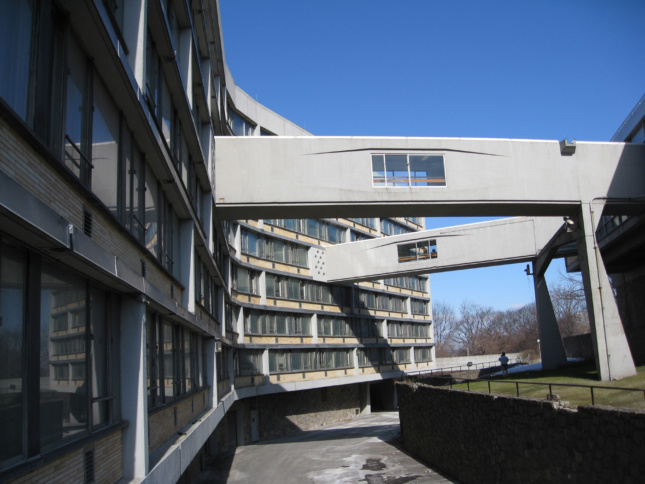Living on Campus: An Architectural History of the American Dormitory
By Carla Yanni
Published by the University of Minnesota Press
MSRP $34.95
Dormitories figure prominently in the popular vision of American college life. They might have different forms, such as buildings surrounding a quadrangle inspired by medieval European universities or functional, modernist structures with an interior array of nearly identical rooms lining both sides of a long hallway. Dorms establish college as more than just a place where a person gains skills and knowledge before going out into the world, getting a job, and getting on with life; they help make higher education a distinctive life experience. Academic leaders have long fostered this concept. Lucy Diggs Slowe, the dean of women at Howard University in the 1920s and ’30s, declared dormitories to be not only “laboratories in human relations,” but also places “for the development of those cultural pursuits that ought to be part of every college student’s life.” In Living on Campus: An Architectural History of the American Dormitory, Carla Yanni, an architectural historian at Rutgers University, examines residence halls not as “mute containers for the temporary storage of youthful bodies and emergent minds.” Rather, in tracing 300 years of this building type, Yanni sees dormitories as evidence of educational ideals, ways to manage new types of students, and broader societal shifts.

The first residence hall was a space of exclusion. Constructed in the 1650s, the Indian College at Harvard University was intended to house 20 indigenous students so they could live near their classes while remaining separated from white students. This building, Yanni argues, demonstrates that “from the very beginning of colleges in North America, student housing existed to establish hierarchies.” The indigenous population differed from the typical college student of the period, namely a white teenage boy from an elite family. College contributed to these students’ individual formation but was also a broader reflection of a flourishing America. Nassau Hall, completed in 1756 at the College of New Jersey, now Princeton University, was “the largest and most distinguished structure in the colony.” The dorm was separated from the street by a spacious lawn and surrounded by farms, which, university leaders argued, provided the isolation from the adjoining settlement and distance from home that gave students the best chance of becoming useful citizens.

Once women began attending college in large numbers in the 19th century, their living quarters functioned as both a sanctuary and a means of surveillance and management. Completed in 1887 at Oberlin College, Baldwin Cottage, designed by Weary and Kramer, offered a homelike environment with a combination of public and private spaces, including a parlor, reception hall, and dining room along with bedrooms. Women living in the dorms were subject to strict rules about walking in the halls and requisite bedtimes, but since male students at Oberlin lacked similar accommodations until 1910, social life at the college revolved around women’s residence halls.
The 1944 GI Bill resulted in a near-doubling of the number of college students in the decade after 1945. Faced with this expanding population, urban universities, such as Rutgers University and New York University, constructed high-rise dormitories that were not only economical but required less land than a leafy, low-rise quadrangle. High-rise dormitories also appeared outside of urban areas, such as the Morrill and Lincoln Towers at Ohio State University, designed by Schooley, Cornelius, and Schooley and completed in 1965, with room for more than 3,800 students. Intended as a response to criticisms about the impersonal appearance of high-rises, the towers’ rooms were arranged in a distinctive honeycomb-shaped plan meant to encourage better communication and raise student morale. Kresge College, by MLTW, which opened in 1973 at the University of California, Santa Cruz, offered a more striking critique of high-rise dormitories as well as the seeming impersonality of a large university: Its low, white buildings were accented with playful red, blue, and yellow supergraphics and housed a mere 270 students. Kresge’s distinctive design was intended to signal the school’s close-knit student and faculty community and experimental curriculum.

Does the image of college life change without the dormitory? Today a considerable number of students attend college beyond their teenage years and early twenties, at community colleges or commuter schools, or exclusively online. Yanni’s conclusion points to these issues regarding the future of dormitories, but the book as a whole raises questions about the relationship between architecture and transformations of the American university. Whether in the shape of a medieval quadrangle, Georgian estate, or high-rise tower, residence halls help maintain the conventional image of an American undergraduate. But shifts in the student body and new resources and buildings to facilitate education will inevitably prompt new stories about higher education in the United States.
Pollyanna Rhee is an architectural and landscape historian at the University of Illinois at Urbana-Champaign.











